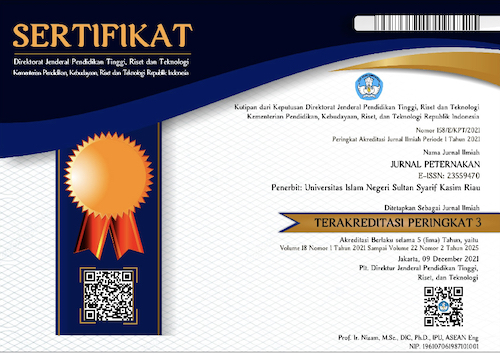The Effects of Slaughter Age and Sex of Broilers Cobb Strain on Live Body Weight, Carcass Weight, and Carcass Percentage
Abstract
Demand for chicken consumption in Indonesia tends to increase every year. Broiler chickens were slaughtered at short age than past years, recently about 4 to 6 weeks. Total of 28 to 42 day old broiler chicks were distributed to completely randomized design in factorial scheme (4,5 and 6 weeks old) and 2 (male and female). All of evaluated were live body weight (LBW), carcass weight (CW), and carcass percentage (CP). Analyzed used Two Way analysis of variane (ANOVA) using SPSS with 5 replication. Duncan Multiple Range Test (DMRT) to determine the differences among treatment means. The result showed that live body weight had unsignificantly effect of sex but affect (P<0.05) to slaughter age (4, 5 and 6 weeks) it was 1460 g, 1881 g and 2310 g. The means of carcass weight with different sex of male and female had unsignificantly effect it was 1.283 g and 1.223, so do the carcass percentage was 69.43 % and 70.15%. This research can be concluded that difference sexing un affect to body weight (1.891 g), carcass weight (1.253 g) and carcass percentage (69.79%), but the female broiler get higher than male broiler. Thus slaughter age affect (P<0.05) to body weight, carcass weight and carcass percentage, at 4 weeks old was tend to decrease but increasily at 5 weeks and 6 weeks old. The best body weight, carcass weight and carcaas percentage at 5 weeks old, according to market demand.
Keywords
Full Text:
PDFReferences
Agus, Ali, and Tri Satya Mastuti Widi. 2018. “Current Situation and Future Prospects for Beef Cattle Production in Indonesia - A Review.” Asian-Australasian Journal of Animal Sciences 31(7): 976–83.
Benyi, Kow, Thendo Stanley Tshilate, Avhafunani Justice Netshipale, and Kgabo Tryphina Mahlako. 2015. “Effects of Genotype and Sex on the Growth Performance and Carcass Characteristics of Broiler Chickens.” Tropical Animal Health and Production 47(7): 1225–31.
Farida, T. E., N. D. Hanafi, and M. Tafsin. 2022. “Comparative Study of Broiler Chicken Performance in Closed House and Conventional System in North Sumatera.” IOP Conference Series: Earth and Environmental Science 977(1).
Farrell, David. 2013. “The Role of Poultry in Human Nutrition by David Farrell.” Poultry development review 2(10): 2–3. http://www.fao.org/3/i3531e/i3531e07.pdf.
Ferlito, C., and H. Respatiadi. 2018. “Policy Reform on Poultry Industry in Indonesia.” Center for Indonesian Policy Studies (5): 1–38.
Fernandes, Jovanir Inês Müller et al. 2013. “Efeito Da Linhagem, Sexo e Idade Nos Parâmetros de Carcaça de Frangos de Corte.” Acta Scientiarum - Animal Sciences 35(1): 99–105.
Hafid, Harapin. 2022. “Growth and Development of Chicken Carcass in Different Sex and Age.” Indonesian Journal of Agricultural Research 05(02): 121–31.
Ikusika, Olusegun O. et al. 2020. “Effect of Strain, Sex and Slaughter Weight on Growth Performance, Carcass Yield and Quality of Broiler Meat.” Open Agriculture 5(1): 607–16.
Indra, Wahyu, Wiwin Tanwiriah, and Tuti Widjastuti. 2015. “Slaughter Weights, Carcass And Income Over Feed Cost Males Sentul Chicken At Different Slaughter Age.” 4(3): 1–10.
Murawska, Daria. 2017. “The Effect of Age on Growth Performance and Carcass Quality Parameters in Different Poultry Species.” Poultry Science (February 2017).
Olawumi, S.O, and S.S Fagbuaro. 2011. “Productive Performance of Three Commercial Broiler Genotypes Reared in the Derived Savannah Zone of Nigeria.” International Journal of Agriculture Research 6(11): 798–804.
Pascalau, Simona, Cadar Mirela, Camelia Raducu, and Zamfir Marchis. 2017. “Evaluation of Productive Performances in Ross 308 and Cobb 500 Hybrids.” Animal Biology & Animal Husbandry 9(1): 22–27. https://www.researchgate.net/publication/332497136_Evaluation_of_productive_performances_in_Ross_308_and_Cobb_500_hybrids%0Ahttp://www.abah.bioflux.com.ro/docs/2017.22-27.pdf.
Petracci, Massimiliano, Francesca Soglia, and Cécile Berri. 2017. “Muscle Metabolism and Meat Quality Abnormalities.” Poultry Quality Evaluation: Quality Attributes and Consumer Values: 51–75.
Vantress, Cobb-. 2018. “Cobb500TM The World’s Most Efficient Broiler.”
Walita, Kamija Z, Jonathan Tanganyika, and Steven R Mussah. 2017. “Effect of Sex, Type of Feed and Age at Slaughter on Carcass Yield Characteristics of Japanese Quails (Cortunix Japonica) In Malawi.” International International Journal of Avian & Wildlife Biology 2(2).
Widnyana, B. A., I P. A Astawa, and N M. S. Sukmawati. 2019. “Persentase Potongan Karkas Broiler Umur 5 Minggu Yang Diberi Bubuk Kunyit Dalam Air Minum.” Journal of Tropical Animal Science 7(2): 934–45.
DOI: http://dx.doi.org/10.24014/jupet.v21i1.23345
Refbacks
- There are currently no refbacks.
Jurnal Peternakan has been accredited by Sinta 3 : Number 158/E/KPT/2021
Starting from Vol. 18 No. 1 Year 2021 to Vol. 22 No. 2 Year 2025
Jurnal Peternakan Indexed By:
Editorial Office:
Jurnal Peternakan
Faculty of Agriculture and Animal Science, State Islamic University of Sultan Syarif Kasim Riau.
H.R. Soebrantas street KM. 15,5 Panam – Pekanbaru city.
E-mail: jurnal.peternakan@uin-suska.ac.id
ejournal: http://ejournal.uin-suska.ac.id/index.php/peternakan

Creation is distributed under the Creative Commons Attribution 4.0 International License. View Mystats














